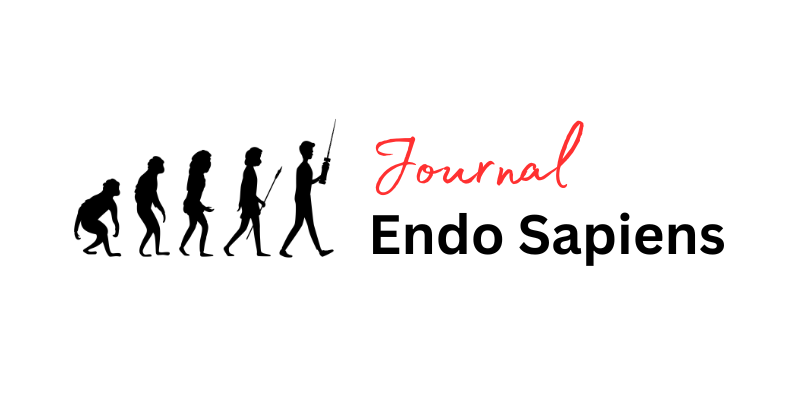
case report
Filling material extrusion into maxillary sinus causing severe pain: resolution via laparoscopic surgery
Márcia Franzoni, PhD 1,2
Fátima G. Bueno-Camilo, DDS M.Ed 1,3
Flávio R. F. Alves, PhD 4,5
José F. Siqueira Jr, PhD 1,4,5
Isabela N. Rôças, PhD 1,4,5
https://doi.org/10.71347/esj42dh78
1 Member of the Endochat research group, Rio de Janeiro, RJ, Brazil
2 Department of Endodontics, Dental Press Cursos, Maringá, Brasil.
3 Postgraduate Program in Endodontics, School of Dentistry, Santo Domingo Catholic University and Autonomous University of Santo Domingo, Santo Domingo, Dominican Republic.
4 Postgraduate Program in Dentistry, University of Grande Rio (UNIGRANRIO), Rio de Janeiro, RJ, Brazil.
5 Department of Endodontics, Faculty of Dentistry, Iguaçu University (UNIG), Nova Iguaçu, RJ, Brazil.
Key words: Apical periodontitis; overfilling; root canal treatment; maxillary sinus
Acknowledgements: The authors deny any conflicts of interest.
Corresponding author:
Flávio R. F. Alves, PhD
Rua Professor José de Souza Herdy, 1160
Duque de Caxias, RJ
Brazil 25071-202
e-mail: flavioferreiraalves@gmail.com
Abstract
Background: Given the anatomical proximity, pathologic conditions and endodontic treatment procedures in maxillary posterior teeth may affect the maxillary sinus.
Case description: This report describes a case of large extrusion of filling material to the maxillary sinus, resulting in persistent acute pain and requiring hospitalization and surgical removal of the material via videolaparoscopy. A 34-year-old female experienced persistent pain in the left upper posterior region of the face, three months after endodontic treatment of tooth 14. Radiographs revealed a large amount of filling material in the maxillary sinus. Despite using analgesics, the pain persisted, with an additional burning sensation in the infraorbital area. The endodontist who treated tooth 14 confirmed that the filling was completed using Tagger’s Hybrid technique with gutta-percha and AH Plus sealer. A cone-beam computed tomography (CBCT) was requested, revealing a missed MB2 canal in tooth 14. Non-surgical endodontic retreatment ameliorated the pain; however, symptoms persisted, necessitating the surgical removal of the extruded material, which was performed via videolaparoscopy. Six months later, the patient was asymptomatic regarding tooth 14, but tooth 13 was extracted and replaced with an implant that later perforated the sinus floor. After implant replacement, the patient's pain was completely resolved.
Conclusions: This case highlights the need for caution when performing endodontic treatment on posterior maxillary teeth due to their proximity to the maxillary sinus. In cases where root apices contact, invade, or are close to the sinus, thermoplasticized root canal obturation techniques should be avoided because of the increased risk of extrusion complications and consequences. CBCT imaging significantly improves diagnostic accuracy in cases with persistent symptoms and is an important tool in treatment planning.
Introduction
The success of endodontic therapy depends on the proper cleaning, shaping, and filling of root canals, as well as effective coronal seal (Siqueira 2001, Siqueira et al. 2005). During treatment, filling materials, irrigants, debris, and microrganisms can be extruded into the periradicular tissues (Alves et al. 2018, Azizi Mazreah et al. 2022, Monteiro et al. 2024).
Al-Dewani N, Hayes SJ, Dummer PM (2000) Comparison of laterally condensed and low-temperature thermoplasticized gutta-percha root fillings. Journal of Endodontics 26, 733-8.
Alves FR, Coutinho MS, Goncalves LS (2014) Endodontic-related facial paresthesia: systematic review. J Can Dent Assoc 80, e13.
Alves FRF, Dias MCC, Mansa M, Machado MD (2020) Permanent Labiomandibular Paresthesia after Bioceramic Sealer Extrusion: A Case Report. J Endod 46, 301-6.
Alves FRF, Paiva PL, Marceliano-Alves MF et al. (2018) Bacteria and Hard Tissue Debris Extrusion and Intracanal Bacterial Reduction Promoted by XP-endo Shaper and Reciproc Instruments. J Endod 44, 1173-8.
Arias A, de la Macorra JC, Hidalgo JJ, Azabal M (2013) Predictive models of pain following root canal treatment: a prospective clinical study. Int Endod J 46, 784-93.
Azizi Mazreah S, Shirvani A, Azizi Mazreah H, Dianat O (2022) Evaluation of irrigant extrusion following the use of different root canal irrigation techniques: A systematic review and meta-analysis. Aust Endod J 49, 396-417.
Bandyopadhyay R, Biswas R, Bhattacherjee S, Pandit N, Ghosh S (2015) Osteomeatal Complex: A Study of Its Anatomical Variation Among Patients Attending North Bengal Medical College and Hospital. Indian J Otolaryngol Head Neck Surg 67, 281-6.
Blanco Fuentes BY, Moreno Monsalve JO, Mesa Herrera U, Amoroso-Silva PA, Rodrigues Ferreira Alves F, Marceliano-Alves MF (2024) Apical periodontitis in endodontically-treated teeth: association between missed canals and quality of endodontic treatment in a Colombian sub-population. A cross-sectional study. Acta Odontol Latinoam 37, 59-67.
Brooks JK, Kleinman JW (2013) Retrieval of extensive gutta-percha extruded into the maxillary sinus: use of 3-dimensional cone-beam computed tomography. J Endod 39, 1189-93.
Costa F, Pacheco-Yanes J, Siqueira JF, Jr. et al. (2019) Association between missed canals and apical periodontitis. Int Endod J 52, 400-6.
Incebeyaz B, Oztas B (2024) Evaluation of osteomeatal complex by cone-beam computed tomography in patients with maxillary sinus pathology and nasal septum deviation. BMC Oral Health 24, 544.
Karabucak B, Bunes A, Chehoud C, Kohli MR, Setzer F (2016) Prevalence of apical periodontitis in endodontically treated premolars and molars with untreated canal: a cone-beam computed tomography study. J Endod 42, 538-41.
Khongkhunthian P, Reichart PA (2001) Aspergillosis of the maxillary sinus as a complication of overfilling root canal material into the sinus: report of two cases. J Endod 27, 476-8.
Metska ME, Aartman IH, Wesselink PR, Ozok AR (2012) Detection of vertical root fractures in vivo in endodontically treated teeth by cone-beam computed tomography scans. J Endod 38, 1344-7.
Monteiro TM, Cortes-Cid VO, Marceliano-Alves MFV et al. (2024) Intracanal removal and apical extrusion of filling material after retreatment using rotary or reciprocating instruments: A new approach using human cadavers. Int Endod Journal 57, 100-7.
Nakamura N, Mitsuyasu T, Ohishi M (2004) Endoscopic removal of a dental implant displaced into the maxillary sinus: technical note. Int J Oral Maxillofac Surg 33, 195-7.
Ok E, Gungor E, Colak M, Altunsoy M, Nur BG, Aglarci OS (2014) Evaluation of the relationship between the maxillary posterior teeth and the sinus floor using cone-beam computed tomography. Surg Radiol Anat 36, 907-14.
Papadopoulou AM, Chrysikos D, Samolis A, Tsakotos G, Troupis T (2021) Anatomical Variations of the Nasal Cavities and Paranasal Sinuses: A Systematic Review. Cureus 13, e12727.
Pereira RS, Guerra RC, Hochuli-Vieira E, Alves FRF (2022) Cavernous sinus thrombosis followed by brain ischaemia in a type-1 diabetic patient: a persistent endodontic infection report. Aust Endod J 48, 510-4.
Ricucci D, Rôças IN, Alves FR, Loghin S, Siqueira JF, Jr. (2016) Apically Extruded Sealers: Fate and Influence on Treatment Outcome. J Endod 42, 243-9.
Schilder H (2006) Filling root canals in three dimensions. 1967. J Endod 32, 281-90.
Signoretti FG, Endo MS, Gomes BP, Montagner F, Tosello FB, Jacinto RC (2011) Persistent extraradicular infection in root-filled asymptomatic human tooth: scanning electron microscopic analysis and microbial investigation after apical microsurgery. J Endod 37, 1696-700.
Siqueira JF, Jr. (2001) Aetiology of root canal treatment failure: why well-treated teeth can fail. Int Endod J 34, 1-10.
Siqueira JF, Jr., Rôças IN, Alves FR, Campos LC (2005) Periradicular status related to the quality of coronal restorations and root canal fillings in a Brazilian population. Oral Surg Oral Med Oral Pathol Oral Radiol Endod 100, 369-74.
Sjogren U, Hagglund B, Sundqvist G, Wing K (1990) Factors affecting the long-term results of endodontic treatment. J Endod 16, 498-504.
Swathika B, Basheer SN, Sriram S, Rajmohan S, Murugesan S, Subramani SK (2024) Comparing Warm and Cold Gutta-Percha Techniques for Root Canal Filling: An In Vitro Study. J Pharm Bioallied Sci 16, S2694-S6.
Tanasiewicz M, Bubilek-Bogacz A, Twardawa H, Skucha-Nowak M, Szklarski T (2017) Foreign body of endodontic origin in the maxillary sinus. J Dent Sci 12, 296-300.
Tataryn RW (2019) Rhinosinusitis and endodontic disease. In I Rotstein, JI Ingle eds. Ingle's endodontics, 7th edn; pp. 439-49. Raleigh, NC: PMPHUSA.
Tian XM, Qian L, Xin XZ, Wei B, Gong Y (2016) An Analysis of the Proximity of Maxillary Posterior Teeth to the Maxillary Sinus Using Cone-beam Computed Tomography. J Endod 42, 371-7.
Yamaguchi K, Matsunaga T, Hayashi Y (2007) Gross extrusion of endodontic obturation materials into the maxillary sinus: a case report. Oral Surg Oral Med Oral Pathol Oral Radiol Endod 104, 131-4.
